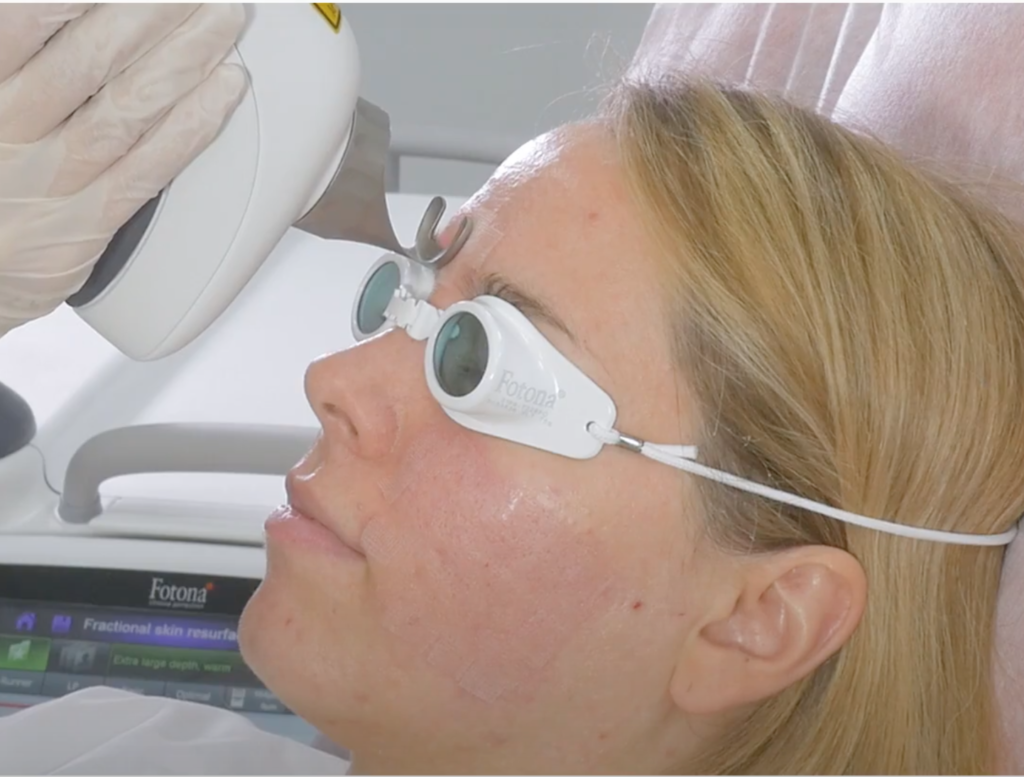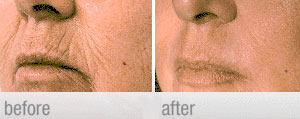ABLATIVE LASER
SKIN RESURFACING
Turn back the clock and peel off the signs of time for a more youthful look!
SUMMARY
Laser skin resurfacing is a nonsurgical procedure that heats up the deeper layers of the superficial skin (epidermis) causing microdamage and triggering the body’s healing response. As the skin regenerates, its tone and texture improves dramatically. Laser skin resurfacing can remove nearly all fine wrinkles while significantly improving deeper wrinkles. Think of it as sanding your wooden floors at home to make them look brand new.
WHERE
Physimed MediSpa, Montreal
ANESTHESIA
Local topical anesthetic
PAIN
Low-mid
LENGTH OF PROCEDURE
30-60
RECOVERY TIME
3-10 days depending on depth
before & after gallery
Click here to view this before and after
INVASIVENESS
Low-mid

Laser skin resurfacing is a nonsurgical procedure that heats up the deeper layers of the superficial skin (epidermis), causing microdamage and triggering the body’s healing response. As the skin regenerates, its tone and texture improves dramatically. This treatment is commonly used to treat fine lines and wrinkles, acne scars, dark spots and freckles, dark circles, crepey skin, dullness, and discoloration. It can also help tighten mild sagging.
The laser beam gently vaporizes micron-thin layers of the epidermis while thermally affecting deeper skin layers to stimulate the production of new collagen in the dermis.
Not all laser resurfacing treatments are the same, and there are two primary categories: ablative and nonablative.
Ablative laser treatments, like our ablative Fotona Erbium laser, remove the surface layer of your skin while heating up the water molecules in its lower layer, triggering the healing response. Depending on the depth of treatment chosen, this skin removal can leave you red and raw, with quite a few days of downtime while your skin heals.
Non-ablative laser treatments, like our non-ablative Fotona Erbium laser, leave the surface of the skin intact, heating only the lower layer. There’s typically little to no significant downtime after non-ablative laser resurfacing.
Ablative vs. non-ablative: Which laser treatment is right for you?
Ablative laser provides more dramatic results in one treatment but requires significant downtime. Non-ablative lasers can also give great results, with no downtime, but typically require multiple sessions.
Both options provide good results for most people, but ablative laser resurfacing provides more dramatic improvement of deeper wrinkles, significant sun damage, or sagging skin.
Fractionated lasers, which break laser energy into thousands of tiny beams that target a fraction (20–40%) of the skin at one time can be either ablative or nonablative. The purpose of breaking up a laser’s energy is to diminish the trauma to the skin—and cut down on the subsequent downtime. An ablative fractionated laser will still leave you red and raw, but healing time is typically shorter than with a fully ablative Erbium laser.
Most people report fantastic results, including a reduction in fine lines and wrinkles, more even tone, softer skin, smoother texture, diminished scarring, and tighter, firmer skin.
Depending on the depths of ablation required for your treatment, you typically need only one treatment of ablative laser resurfacing to see fantastic improvement.
You’ll see ablative laser resurfacing results once the peeling and (some of) the redness has subsided post-treatment, usually after 10–14 days. Full results may take three to six months to see; it can take that long for all new collagen to be generated.
Think of it as trying to give a nice glow and finish to your wooden floors at home. If you want a more dramatic result, you can sand your floors instead of simply buffing them. Sanding your wooden floors is equivalent to using a fully ablative laser to resurface your skin.
Nonablative laser resurfacing results appear over the course of several months, so they may feel more subtle than an ablative treatment. But once you’ve completed your series of treatments, you should notice a significant difference in tone and texture, with further improvement for several more months.
Both ablative and nonablative laser resurfacing treatment results should last several years (8 to 10 years), though nothing will stop the effects of time. Your skin will continue to change with age and exposure to environmental factors like sunlight.
Prior to your appointment, we may prescribe an antiviral medication (if you are prone to cold sores) and an antibiotic to reduce the risk of infection. We may have you use a topical retinoid for a month prior or ask you to go through 2 sessions of microdermabrasion to help boost cell turnover. We will also ask you to stay out of the sun for two weeks prior to your treatment and for a month afterward, because a tan can sometimes lead to pigmentation problems.
Ablative laser resurfacing is usually performed in our procedure room. You’ll be given a local anesthetic to numb your skin. We will then use the ablative laser to remove the outer layer of your skin as well as heat the inner skin layers. This triggers your skin’s healing response, stimulates collagen production, and causes existing collagen fibers to shrink, tightening and smoothing your skin from the inside.
The treatment can take from 30-60 minutes depending on the size of the area. Afterward, we will apply a healing ointment and give you some to put on in the first few days at home.
You should expect to take a few days off work while your skin heals. The deeper the ablation, the more downtime is to be expected. Right after, your skin will look quite sunburned. It may be raw, swollen, itchy, and blistered. Your skin may even ooze for a few days, followed by crusting and peeling. You should resist the temptation to pick or scratch your healing skin since it can cause scarring.
For the first few days, you’ll also need to be especially diligent about hygiene and clean your skin several times a day with a saline or vinegar solution, followed by a moisturizer. Some swelling is also normal. Sleeping on an extra pillow and applying ice packs may help alleviate swelling.
After 7 days, when most of the peeling is done, you can usually start wearing oil-free makeup to hide the redness. Your skin may remain pinkish for several weeks, especially if you’re naturally fair-skinned. You will need to religiously use a broad-spectrum sunscreen (SPF 30 or higher) daily, to protect your new baby skin.
Anyone of a mature age or younger patients with significant damaged skin, like severe acne scars, can benefit from a fully ablative laser resurfacing to rejuvenate their skin. At Physimed MediSpa, we use the Fotona Erbium YAG fully ablative laser which can be used on all skin types. However, caution should be used on patients with darker skin complexion in order to avoid hyperpigmentation.
Fully ablative laser resurfacing is primarily used on the face.
With Ablative Laser Resurfacing, you’d have five to seven days of downtime post-treatment.
With non-ablative Laser Resurfacing, there is limited downtime, but a series of 3 to 6 non-ablative laser treatments is needed to achieve the result of one ablative laser treatment. With non-ablative laser treatment, you may have pinkness or mild swelling for anywhere from a few hours to a few days afterward (depending on the intensity of your treatment), but you should be able to return to your normal activities immediately.
This treatment may also trigger an outbreak of cold sores, if you’re prone to them. We will prescribe antiviral medication to be safe.
While laser resurfacing treatments are considered safe, patients with dark skin run the risk of developing hyperpigmentation after ablative laser resurfacing.
It is often a good idea to combine laser resurfacing with IPL (intense pulsed light) treatments, to keep sun damage or brown and red spots under control.
You should consider these nonsurgical skin-rejuvenating treatments too, if improved tone and texture is your goal.
Microdermabrasion sloughs away dead skin cells using diamond tips to help exfoliate the superficial layer of the skin.
Chemical peels come in a range of strengths and remove layers of skin to reveal fresh, new skin beneath.
Micro-needling mechanically punctures the top layer of your skin with tiny needles, creating micro injuries that stimulate your skin’s healing response and boost collagen and elastin production.
Fractional lasers thermally puncture the top layer on your skin. The beam is broken up into smaller units, so they only target between 25% and 40% of the skin, leaving the rest intact. The surrounding intact skin helps jump-start healing, stimulating the production of collagen and the turnover of new cells.
For more information, ask for a free consultation with an aesthetics doctor.


